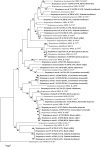Western Bats as a Reservoir of Novel Streptomyces Species with Antifungal Activity
- PMID: 27986729
- PMCID: PMC5311414
- DOI: 10.1128/AEM.03057-16
Western Bats as a Reservoir of Novel Streptomyces Species with Antifungal Activity
Abstract
At least two-thirds of commercial antibiotics today are derived from Actinobacteria, more specifically from the genus Streptomyces Antibiotic resistance and new emerging diseases pose great challenges in the field of microbiology. Cave systems, in which actinobacteria are ubiquitous and abundant, represent new opportunities for the discovery of novel bacterial species and the study of their interactions with emergent pathogens. White-nose syndrome is an invasive bat disease caused by the fungus Pseudogymnoascus destructans, which has killed more than six million bats in the last 7 years. In this study, we isolated naturally occurring actinobacteria from white-nose syndrome (WNS)-free bats from five cave systems and surface locations in the vicinity in New Mexico and Arizona, USA. We sequenced the 16S rRNA region and tested 632 isolates from 12 different bat species using a bilayer plate method to evaluate antifungal activity. Thirty-six actinobacteria inhibited or stopped the growth of P. destructans, with 32 (88.9%) actinobacteria belonging to the genus Streptomyces Isolates in the genera Rhodococcus, Streptosporangium, Luteipulveratus, and Nocardiopsis also showed inhibition. Twenty-five of the isolates with antifungal activity against P. destructans represent 15 novel Streptomyces spp. based on multilocus sequence analysis. Our results suggest that bats in western North America caves possess novel bacterial microbiota with the potential to inhibit P. destructansIMPORTANCE This study reports the largest collection of actinobacteria from bats with activity against Pseudogymnoascus destructans, the fungal causative agent of white-nose syndrome. Using multigene analysis, we discovered 15 potential novel species. This research demonstrates that bats and caves may serve as a rich reservoir for novel Streptomyces species with antimicrobial bioactive compounds.
Keywords: Actinobacteria; Pseudogymnoascus; Streptomyces; bats; caves; white-nose syndrome.
Copyright © 2017 American Society for Microbiology.
Figures

References
-
- Hopwood DA. 2007. Streptomyces in nature and medicine: the antibiotic makers. Oxford University Press, New York, NY.
Publication types
MeSH terms
Substances
LinkOut - more resources
Full Text Sources
Other Literature Sources
Molecular Biology Databases
Miscellaneous

